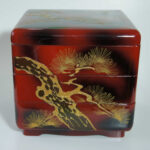Jubako(food boxes)
Jubako(food boxes), traditional Japanese stacked food boxes, boast a long history dating back to ancient times, particularly the Nara period (8th century AD). The origins of jubako (food boxes)can be traced back to China, where wooden stacked boxes served as containers for transporting meals. This cultural practice was introduced to Japan, where it became essential for carrying meals. Jubako(food boxes), also known as “重箱” in Japanese, is a stacked box used for packing traditional Japanese dishes and bento (boxed lunches). Typically crafted from wood or plastic, it comprises multiple tiers and is commonly utilized for special occasions such as New Year’s celebrations, presenting dishes beautifully while preserving the flavors and aromas of the ingredients.
During the Heian period (late 9th to 12th century), jubako(food boxes) became commonplace among the aristocracy and courtiers. In aristocratic circles, exquisitely arranged jubako (food boxes)dishes played a significant role during meals. Over time, the use of jubako(food boxes) expanded to encompass samurai culture and the general populace, becoming a familiar sight during everyday meals and outings in the Edo period (17th to 19th century).That food boxes served not only as a means of transporting meals but also as a way to preserve and prevent ingredients from drying out during transit. With multiple tiers, each box allowed for the segregation of different types of dishes, aiding in balancing the meal.
